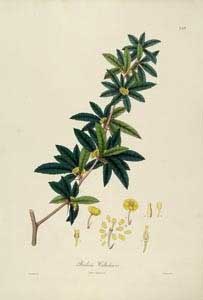Produce becberin by biotechnology
Experts from the Institute of Biotechnology have successfully researched the rapid multiplication of tissue biomass of Barberry plants to produce artificial sources of becberin, replacing the scarce natural resources.
 With this procedure, after about 3-4 weeks of tissue culture of thorny thorns, a large amount of tissue can be obtained dozens of times the initial amount.
With this procedure, after about 3-4 weeks of tissue culture of thorny thorns, a large amount of tissue can be obtained dozens of times the initial amount.
These are cell blocks containing becberin with the same quality and content as becberin in the natural prickly roots of thorns (3-4% of dry weight of roots). Meanwhile, to collect roots of prickly thorns, must wait for the tree to be 3-5 years old.
In addition to the rapid multiplication process of biomass, scientists also studied the process of rapid multiplication of Hoang Lien thorn seedlings by asexual method. The goal is to provide sufficient seedlings for future areas of material planting.
According to Dr. Dinh Thi Thu Hien, head of the research team of Plant Cell Technology Department, the above two processes can help Vietnam actively create sufficient sources of becberin medicinal materials, serving the huge demand today. At the same time, the process also helps to preserve the natural gene pool, avoiding the prickly tree from the brink of extinction - the barberry has been listed in the Vietnam Red Book due to over-exploitation.
Known to have becberin, domestic pharmaceutical companies have to import or extract from some other plant species.
However, the proportions of becberin in Barberry and Pinus spp. Are among the highest among plants containing becberin (3-7% in roots and roots). Today, the most important application of becberin is the effective treatment of intestinal, dysentery, and trachoma eye infections. Moreover, this active ingredient is less toxic and less expensive.
- London began producing DNA for biotechnology
- Many new studies at biotechnology conferences
- Application of biotechnology in the processing industry
- Cuba biotechnology has great development potential
- Cuba - China cooperates on biotechnology
- Ho Chi Minh City: Biotechnology has not met practical needs
- Exchange of German-Vietnamese biotechnology experiences
- Can produce artificial meat
- Agricultural biotechnology is changing lives
- Identify gender to produce high yielding dairy cows
- Producing bioenergy from diseased plants
- The biggest barrier of biotechnology in Vietnam?
 Green tea cleans teeth better than mouthwash?
Green tea cleans teeth better than mouthwash? Death kiss: This is why you should not let anyone kiss your baby's lips
Death kiss: This is why you should not let anyone kiss your baby's lips What is salmonellosis?
What is salmonellosis? Caution should be exercised when using aloe vera through eating and drinking
Caution should be exercised when using aloe vera through eating and drinking